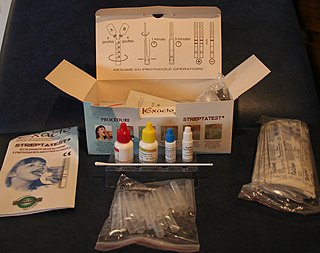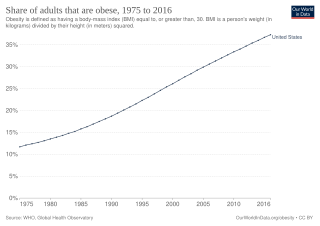
The Centers for Disease Control and Prevention (CDC) is the national public health agency of the United States. It is a United States federal agency under the Department of Health and Human Services, and is headquartered in Atlanta, Georgia.
The International Classification of Diseases (ICD) is a globally used medical classification used in epidemiology, health management and for clinical purposes. The ICD is maintained by the World Health Organization (WHO), which is the directing and coordinating authority for health within the United Nations System. The ICD is originally designed as a health care classification system, providing a system of diagnostic codes for classifying diseases, including nuanced classifications of a wide variety of signs, symptoms, abnormal findings, complaints, social circumstances, and external causes of injury or disease. This system is designed to map health conditions to corresponding generic categories together with specific variations, assigning for these a designated code, up to six characters long. Thus, major categories are designed to include a set of similar diseases.

A drug overdose is the ingestion or application of a drug or other substance in quantities much greater than are recommended. Typically it is used for cases when a risk to health will potentially result. An overdose may result in a toxic state or death.
The National Center for Health Statistics (NCHS) is a U.S. government agency that provides statistical information to guide actions and policies to improve the public health of the American people. It is a unit of the Centers for Disease Control and Prevention (CDC) and a principal agency of the U.S. Federal Statistical System. It is headquartered at University Town Center in Hyattsville, Maryland, just outside Washington, D.C.
Public health informatics has been defined as the systematic application of information and computer science and technology to public health practice, research, and learning. It is one of the subdomains of health informatics.
NORC at the University of Chicago is one of the largest independent social research organizations in the United States. Established in 1941 as the National Opinion Research Center, its corporate headquarters is located in downtown Chicago, with offices in several other locations throughout the United States. Organized as an independent corporation, more than half its board comes from faculty and administration of the University of Chicago. It also jointly staffs some of the university's academic research centers.
Hyposmia, or microsmia, is a reduced ability to smell and to detect odors. A related condition is anosmia, in which no odors can be detected. Some of the causes of olfaction problems are allergies, nasal polyps, viral infections and head trauma. In 2012 an estimated 9.8 million people aged 40 and older in the United States had hyposmia and an additional 3.4 million had anosmia/severe hyposmia.
The Association of Public Health Laboratories (APHL) is a membership organization in the United States representing the laboratories that protect the health and safety of the public. APHL serves as a liaison between public health laboratories and federal and international agencies. Membership consists of local, state, county, and territorial public health laboratories; public health environmental, agricultural and veterinary laboratories; and corporations and individuals with an interest in public health and laboratory science. APHL is a non-profit, 501(c)(3) organization with a history of over fifty years.

A growth chart is used by pediatricians and other health care providers to follow a child's growth over time. Growth charts have been constructed by observing the growth of large numbers of healthy children over time. The height, weight, and head circumference of a child can be compared to the expected parameters of children of the same age and sex to determine whether the child is growing appropriately. Growth charts can also be used to predict the expected adult height and weight of a child because, in general, children maintain a fairly constant growth curve. When a child deviates from his or her previously established growth curve, investigation into the cause is generally warranted. Parameters used to analyze growth charts include weight velocity, height velocity, and whether someone's growth chart crosses percentiles. For instance, endocrine disorders can be associated with a decrease in height velocity and preserved weight velocity while normal growth variants are associated with a decrease in height and weight velocity that are proportional to each other. It's important to note that other parameters are more commonly used such as waist circumference for assessing obesity and skin fold difference for assessing malnutrition. Growth charts can also be compiled with a portion of the population deemed to have been raised in more or less ideal environments, such as nutrition that conforms to pediatric guidelines, and no maternal smoking. Charts from these sources end up with slightly taller but thinner averages.

Point-of-care testing (POCT), also called near-patient testing or bedside testing, is defined as medical diagnostic testing at or near the point of care—that is, at the time and place of patient care. This contrasts with the historical pattern in which testing was wholly or mostly confined to the medical laboratory, which entailed sending off specimens away from the point of care and then waiting hours or days to learn the results, during which time care must continue without the desired information.
The Centers for Disease Control and Prevention, formed in 1946, is the leading national public health institute of the United States. It is a United States federal agency, under the United States Department of Health and Human Services. Its main goal is to protect public health and safety through the control and prevention of disease, injury, and disability in the US and internationally.
The Radiation Effects Research Foundation (RERF) is a joint U.S.-Japan research organization responsible for studying the medical effects of radiation and associated diseases in humans for the welfare of the survivors and all humankind. The organization's scientific laboratories are located in Hiroshima and Nagasaki, Japan.
Workplace health surveillance or occupational health surveillance (U.S.) is the ongoing systematic collection, analysis, and dissemination of exposure and health data on groups of workers. The Joint ILO/WHO Committee on Occupational Health at its 12th Session in 1995 defined an occupational health surveillance system as "a system which includes a functional capacity for data collection, analysis and dissemination linked to occupational health programmes".

Obesity is common in the United States and is a major health issue associated with numerous diseases, specifically an increased risk of certain types of cancer, coronary artery disease, type 2 diabetes, stroke, and cardiovascular disease, as well as significant increases in early mortality and economic costs.
Digit symbol substitution test (DSST) is a neuropsychological test sensitive to brain damage, dementia, age and depression. The test is not sensitive to the location of brain-damage. It consists of digit-symbol pairs followed by a list of digits. Under each digit the subject should write down the corresponding symbol as fast as possible. The number of correct symbols within the allowed time is measured.
In analytical chemistry, biomonitoring is the measurement of the body burden of toxic chemical compounds, elements, or their metabolites, in biological substances. Often, these measurements are done in blood and urine. Biomonitoring is performed in both environmental health, and in occupational safety and health as a means of exposure assessment and workplace health surveillance.

The history of military nutrition in the United States can be roughly divided into seven historical eras, from the founding of the country to the present day, based on advances in food research technology and methodologies for the improvement of the overall health and nutritional status of U.S. military service members. Through the research and guidance of medical and military professionals, rations and packaging have been consistently and dramatically improved.
The National Health Interview Survey (NHIS) is an annual, cross-sectional survey intended to provide nationally representative estimates on a wide range of health status and utilization measures among the nonmilitary, noninstitutionalized population of the United States. Each annual data set can be used to examine the disease burden and access to care that individuals and families are currently experiencing in the United States.
Prevalence of childhood obesity has increased worldwide. The world health organization (WHO) estimated that 39 million children younger than 5 years of age were overweight or had obesity in 2020, and that 340 million children between 5 and 19 were overweight or had obesity in 2016. If the trend continues at the same rate as seen after the year 2000, it could have been expected that there would be more children with obesity than moderate or severe undernutrition in 2022. However, the Covid-19 pandemic will most likely effect the prevalence of undernutrition and obesity





